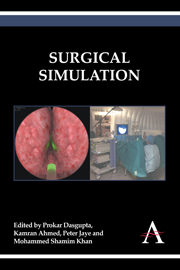Book contents
- Frontmatter
- Contents
- 1 Surgical Simulation: An Overview
- 2 Simulation in Historical Perspective: The History of Medical and Surgical Simulation
- 3 The Role of Animal Models in Surgical Training and Assessment
- 4 Full Procedural Surgical Simulation
- 5 Developing Non-technical Skills
- 6 Learning Curves for Simulators
- 7 Developing a Simulation Programme
- 8 Patient Safety and Simulation
- 9 Psychometrics
- 10 Future of Surgical Simulation
- Author Details
3 - The Role of Animal Models in Surgical Training and Assessment
Published online by Cambridge University Press: 05 April 2014
- Frontmatter
- Contents
- 1 Surgical Simulation: An Overview
- 2 Simulation in Historical Perspective: The History of Medical and Surgical Simulation
- 3 The Role of Animal Models in Surgical Training and Assessment
- 4 Full Procedural Surgical Simulation
- 5 Developing Non-technical Skills
- 6 Learning Curves for Simulators
- 7 Developing a Simulation Programme
- 8 Patient Safety and Simulation
- 9 Psychometrics
- 10 Future of Surgical Simulation
- Author Details
Summary
Abstract
Simulation is of paramount importance to practising skills, problem solving and judgement, and animal models provide the cornerstone of this method. Research advocates a combination of training with bench and animal models and simulation. The animal model used most often is the pig because its anatomy is very similar to humans'. In research, mice, rats and rabbits are largely used because they are easier to handle and less costly.
The training and implementation of minimally invasive surgery demands extensive resources. The most realistic way to train and observe trainees in specific procedures is by using animal-based models due to the realistic nature of their tissue and blood flow. It is important that the trainee masters basic procedures, some of which include positioning the patient, becoming familiar with instrumentation and understanding the potential complications of the operation peri-operatively. All this can be learned in a wet lab in a quiet atmosphere. Wet lab training may also be utilised for the selection of potential trainees and when offering careers to junior doctors.
During the last decade many wet laboratories have opened and many commercial companies have started to run courses in well-equipped, hightech laboratories with state-of-the-art instrumentation available. In addition, it is important that hospitals are well equipped and involved in simulation in order to offer local training.
It is essential that future studies focus on the design and validation of training models and a comprehensive curriculum for the training and assessment of cognitive, technical and non-technical components.
- Type
- Chapter
- Information
- Surgical Simulation , pp. 23 - 40Publisher: Anthem PressPrint publication year: 2014

